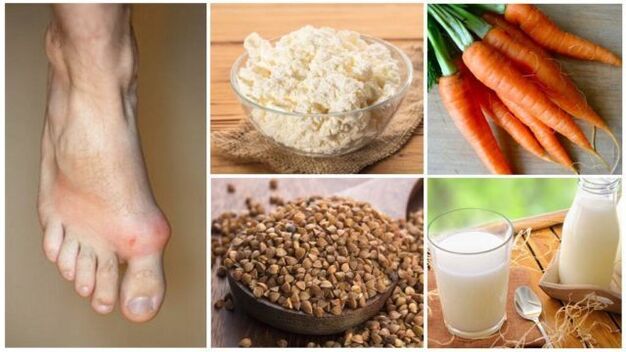
Improper nutrition, combined with poor absorption of nutrients, leads to the development of gout. The disease develops when the level of uric acid in the blood exceeds the allowable limit (for men it exceeds 420 μmol / l, for women - 350 μmol / l). Disruption of metabolic processes leads to the fact that these acid salts settle in the intestinal wall, blood vessels, on the articular surface, and damage vital organs of human life.
Over time, the disease becomes chronic with recurrence. In the acute period, the patient experiences unusual pain at the site of localization of the pathological process. Diet for gout helps normalize uric acid levels and reduces the incidence of relapses.
Why diet for gout?
An important task of therapeutic measures is to reduce the nature, frequency of manifestations of the disease. This can be achieved by reducing the content of uric acid in the body.
The development of gout attacks is caused by:
- consuming large amounts of foods containing purines;
- metabolic disorders.
Dietary optimization allows you to begin the process of proper assimilation and excretion of nutrients. Therapeutic measures aimed at eliminating the causes of the development of this disease are interrelated with compliance with the restrictions of some food addictions. With the help of a properly arranged food menu, you can slow down the progression of the disease.
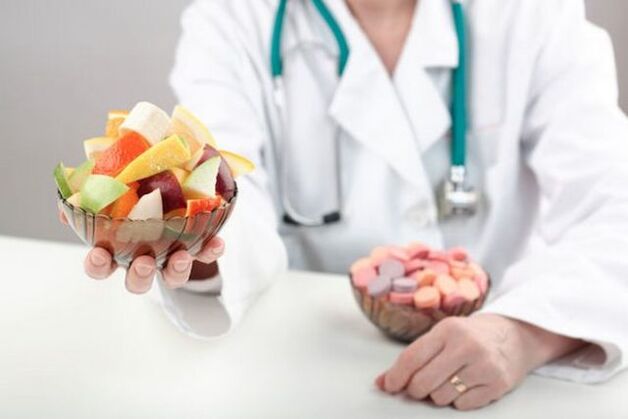
Foods that make up a person’s daily diet should include foods that have large amounts of nutrients that are beneficial to the body.
Nutritional therapy for gout aims to reduce the manifestation of symptoms by eliminating the food components that provoke them. The products that a person consumes every day have a remarkable effect on the state of health in general, responsible for the chemical processes that take place in the human body throughout his life.
What not to eat with gout?
Based on the study, scientists have identified a list of products that directly provoke the main development of the disease and its further development.
The list of what not to eat for gout includes:
- smoked spicy cheese products and cheese;
- meat and bone products rich in cholesterol (pulp of young animals and pigs, nails, buldyzhki);
- flesh and bone fat, ears;
- fish with high fat content (sardines, sprats);
- pickled vegetables, pickled fruits (cabbage, watermelon, cucumber, apple);
- hot, cold smoked products;
- legumes (peas, beans, soybeans, lentils);
- greens, which contain oxalic acid (spinach leaves, sorrel, rhubarb root);
- hot spices, sauces;
- several types of vegetable crops (Brussels sprouts and cauliflower, radish);
- internal organs of animals obtained during carcass slaughter (kidneys, liver, lungs, heart, brain);
- grated oats;
- products that use candy fat;
- alcohol of any percentage;
- fruits and berries (grapes, raspberries, figs);
- hot, spicy and delicate spices (bay leaves, carrots, rice chili);
- fat products and oils from animals (lard, margarine, lard);
- canned meat, fish and vegetable products.
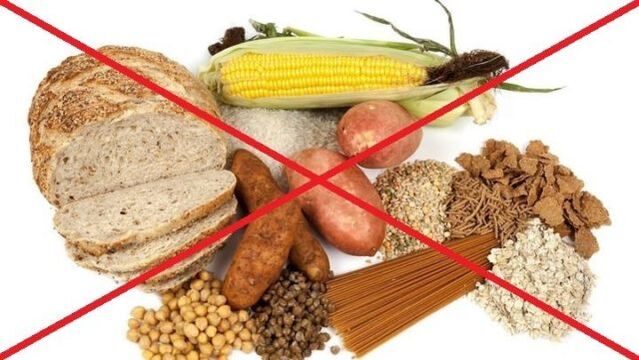
If the diet is unbalanced or contains large amounts of fatty, spicy or heavy foods for the digestive system, then a person’s metabolism may be disturbed.
List of products, the use of which is recommended to be restricted:
- coffee, strong tea;
- butter;
- plum;
- nighthade vegetables (eggplant, tomatoes, peppers);
- table salt, granulated sugar;
- mushrooms (exclusive at the time of remission).
To relieve an attack, as well as maintain a state of remission, it is important to remove the above foods from the diet for a long period of time.
What can you eat with gout?
List of foods recommended for use by patients with this disease:
- dietary meat products (rabbit, poultry, lean beef);
- lean white fish (pike, pike perch, cod, pollock);
- bran and rye bread;
- chicken eggs (excluding egg yolks);
- cereal dishes (rice, wheat, buckwheat, millet, pearl barley);
- fresh vegetables (beets, carrots, cucumbers, cabbage, potatoes);
- seasonal fruits, berries (melons, watermelons, apricots, strawberries, peaches, cherries, blackberries, green apples);
- pasta;
- peanut seeds (hazel, walnut, cedar);
- herbal teas and decoctions (Dubrovnik, basil, catnip);
- fermented dairy products, cottage cheese;
- fresh juices, fruit drinks, compotes;
- ripe tomatoes;
- spices (turmeric, fennel, basil);
- vegetable oils (olive, rapeseed).
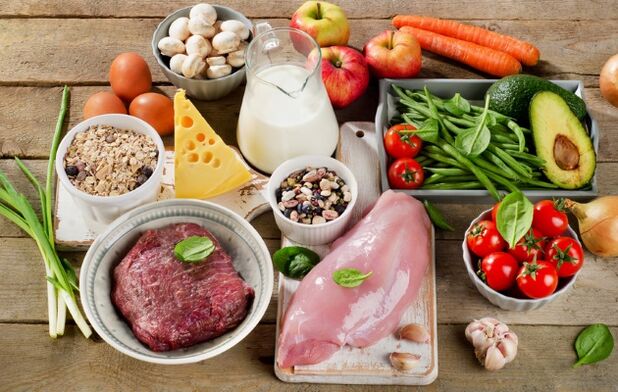
Nutritional therapy for gout will help patients quickly get rid of unpleasant and painful symptoms at home.
In limited amounts, natural honey is useful for gout. This product is suitable as a sugar substitute.
Honey has many beneficial properties:
- immunostimulation;
- antioxidants;
- improve metabolic processes;
- bacteria.
In the acute period, you should not abuse this bee product. Patients with this disease should eat foods rich in vitamins, trace elements, amino acids. A useful supplement is pharmaceutical fish oil for gout.
General food rules
Removing certain forbidden foods from the regular menu does not guarantee immediate relief. In addition, the list of products varies, depending on the stage and severity of the disease. Thus, nutrition for gout during exacerbations involves compliance with stricter restrictions than during remission.
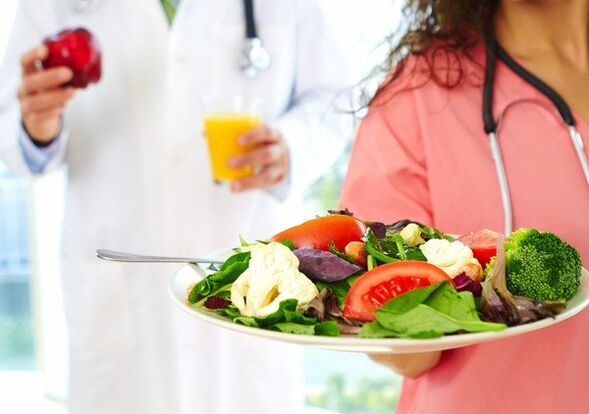
There are a group of general rules for patients with this disease, which are important in dietary care:
- Eat food in small portions several times a day at short intervals (5-6 times). Starvation causes an increase in acetone in the urine. And this can exacerbate the course of the disease.
- Chew food carefully, do not overeat.
- Limit the amount of table salt used in the preparation of meals (up to 5 grams per day). Salt has the property of retaining fluid in the tissues, which in turn requires the deposition of uric acid salts.
- Optimizing body fluid balance. To do this, it is recommended to drink it at least 2 liters a day.
- Arrange a fasting day. Preferably vegetables, dairy and fruit (except those that are forbidden to eat).
- Adhere to restrictions for a long time, because the use of short -term therapeutic diets is ineffective.
People who suffer from severe metabolic disorders and with a history of diabetes and gout should exclude meals that cause spikes of uric acid and insulin levels in the blood. Diets for gout and diabetes are designed to reduce these indicators, to prevent the development of complications and complications.
How to prepare food properly?
Retail list restrictions aren’t the only thing to look out for. It is important to choose the right cooking method while preparing your food.
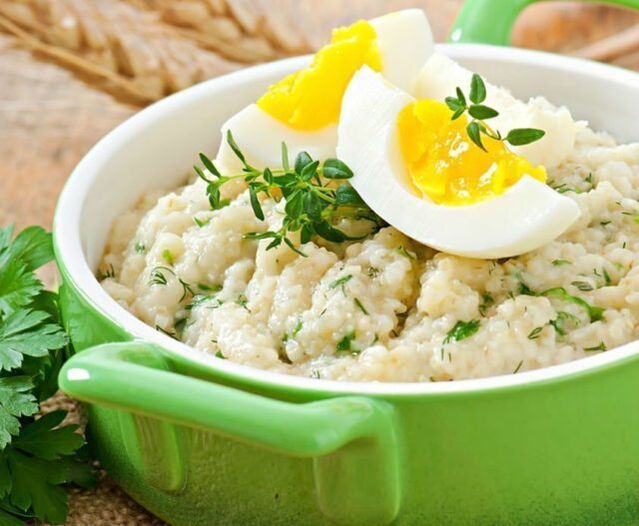
There are no special requirements for the preparation of the product, except for meat processing.
Cooking is allowed in the following ways:
- for couples;
- baking;
- blackout;
- boil;
- patients.
Cuisine is contraindicated by:
- frying;
- smoking;
- salted and pickled;
- fermentation.
Do not use stale and burnt food. The temperature regime of the food consumed should be optimal for the food and not exceed a temperature of 40 degrees Celsius. Food should not be rough and tough. If necessary, individual dishes can be chopped using a blender.
Effective diet: menu for each day
Medical nutrition in terms of the content of essential components (protein-carbohydrate-fat balance), calories, vitamins, micronutrients, amino acids should be in accordance with the physiological needs of the patient.
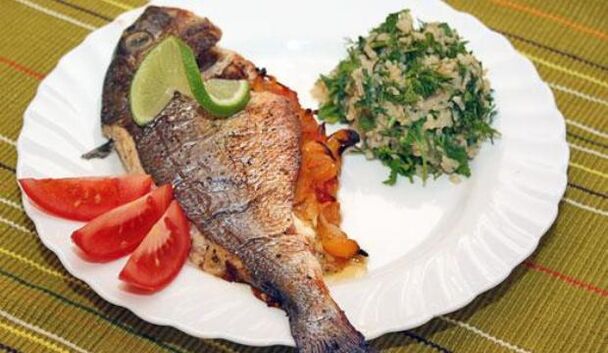
Budget diet for gout and high uric acid:
1 day
Breakfast: boiled cod, mashed potatoes, black bread, white cabbage salad, seasoned with sour cream, a cup of weak coffee with saccharin.
Second breakfast: cottage cheese casserole, boiled eggs, bran bread, tea drinks.
For lunch: vegetarian soup with fried roots and potatoes, boiled beef, buckwheat porridge, fresh cucumber, 1 apple.
Dinner: pieces of carrot meat, pasta, milk, biscuit biscuits.
At night: 200 ml of kefir.
Day 2
First breakfast: boiled white cabbage, 1 boiled egg, black bread, cappuccino.
Second breakfast: cappuccino, biscuit biscuits.
For lunch: lean borscht, bran bread, grilled chicken fillets, boiled rice, fruit jelly.
For dinner: boiled potatoes with vegetables, vegetable casserole, bran bread with butter, a glass of broth.
At night: 250 ml of curdled milk.

Day 3
First breakfast: vegetable salad (white cabbage, carrots, apples), weak coffee.
Second breakfast: cottage cheese with sour cream, rosehip broth.
For lunch: barley soup with sour cream, steamed pieces, mashed potatoes, berry jelly, whole wheat bread.
For dinner: slices of carrot with fruit, semolina casserole, a glass of milk.
Before bed: steamed prunes.
Day 4
Breakfast: grated carrots with sour cream, oatmeal, a glass of green tea.
Second breakfast: pieces of dried fruit, compote, biscuit biscuits.
For lunch: milk noodles, boiled chicken with pumpkin and baked potatoes, fruit jelly, black bread.
For dinner: cheesecake baked in the oven, carrots and apple slices, a glass of tea with lemon.
At night: 200 ml of warm milk.
Day 5
Breakfast: porridge cooked in buckwheat milk, green tea.
Second breakfast: a glass of fresh radish.
For lunch: vegetable rice soup with sour cream, boiled beef porridge, beet caviar, basil infusion with honey, black bread.
For dinner: pumpkin casserole with sour cream, a glass of weak tea, crackers.
Before bedtime: rosehip infused with honey.
6 days
Breakfast: chicken protein omelet, boiled beets, white bread, a glass of weak coffee.
Second breakfast: zucchini casserole, fruit and berry compote.
Lunch: vegetarian barley soup, boiled potatoes, boiled meatballs, jelly, black bread.
Dinner: rice boiled in milk, weak tea drink.
Before bed: a glass of yogurt.
The standard diet regimen is made by the doctor. Combination options for permitted foods are varied. Diet number 6 is common for gout. Its main principles are the exclusion of foods and dishes with high purine components, the addition of alkaline beverages into the food, and gentle processing during cooking. An independently arranged menu with restrictions on the amount and nature of the food can cause the disease to linger.















































































